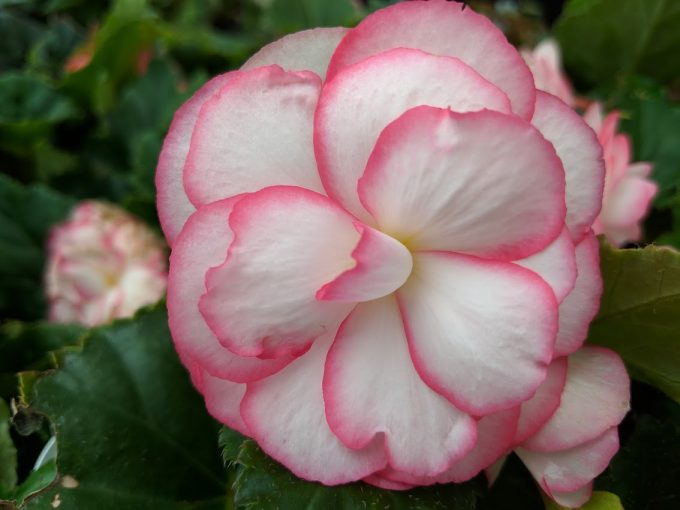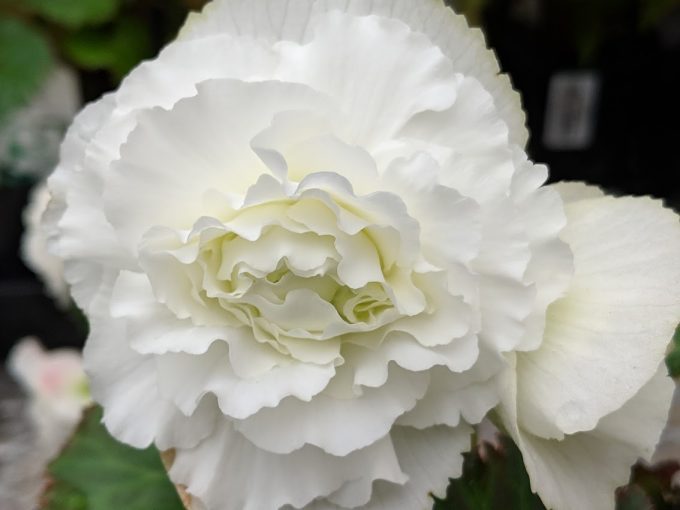I love begonias, and it’s always puzzled me why more people don’t feel the same. Begonias are generally easy to grow, assuming you have very early morning sun or light shade that most of them prefer. Tagawa’s carries a rich variety of different types of begonias in colors ranging from soft and delicate to sizzling and bold.
Maybe it’s time to give these beautiful annuals a closer look and see if they don’t deserve a spot in your summer garden.
My personal favorite: the “nonstop” begonias
Their name says it all. Nonstop begonias start blooming as soon as it’s safe to set them out when all chance of frost has passed. They’ll keep producing lots of large, showy flowers until cold weather threatens in the fall.
These blossoms are elegant and impressive! Semi-double to double blossoms come in a variety of colors including white, red, yellow, apricot and salmon.
Like most begonias, nonstops are excellent in bright shade. Mine get a bit of soft morning sun, but then thrive under the dappled shade of my pine trees as the sun gets higher in the sky. Given stronger direct sun, the plants just fry! Ouch!
Begonias in general do best in light, rich, well-drained soil that’s kept on the slightly moist side, but never soggy. Nonstop begonias are grown from “corms.” Corms are slightly bowl-shaped food storage structures that generate the plant’s above-ground growth. If the corms are kept too wet, they’ll rot. A waste of a beautiful plant!
Another winner: “Wax” begonias
Wax begonias get their name from their shiny, lustrous leaves that look as if they’ve been polished. They have smaller flowers than the nonstop varieties, but easily make up for that in the sheer number of blossoms they produce.
Wax begonias are easy to grow. They’re more upright than the nonstop varieties. They’ll be happiest in full to part shade, with well-draining soil that’s kept slightly but evenly moist. These wax varieties will flower all season long. Blossoms come in white, and shades of pink and red.
“Rex” begonias
The beautiful rex begonias are grown for their wonderful leaves, not the insignificant flowers they produce. The plants are actually more attractive if those blossoms are pinched off as they appear.
Rex begonias can be show stoppers with the stunning multi-colored patterns on their foliage. Like the other begonias shown here, the rex begonias won’t tolerate either strong sun or hot, drying winds. Grow them in a place where they can be protected from some of the challenges our Front Range climate presents. Rex begonias also make nice houseplants if they can be given enough good indirect light.
In summary, tips for growing begonias
- Very early morning sun only, or partial to full shade all day long
- Soil should be rich but light and well-draining
- Water when the top of the soil feels dry to the touch
- Pinch off blossoms and leaves as soon as they begin to discolor
- Fertilize with an all-purpose plant food at half-strength every ten days
- Rex and wax begonias can be brought in and grown as houseplants if there is sufficient diffused indoor light
- Nonstop begonias can be saved by storing the corms over the winter. Remove most of the soil, let the corms air dry for a few days, then store in a small container with peat moss or perlite at ~50* for the winter. Water the storage medium lightly (not the corms themselves) a few times over the winter… just enough to keep the corms from drying out.
If you grow begonias and fall in love with them as I have, take some close-up pictures and send them to Tagawa’s [tagawaqanda@tagawagardens.com]. We’d be so happy to share in your success!







